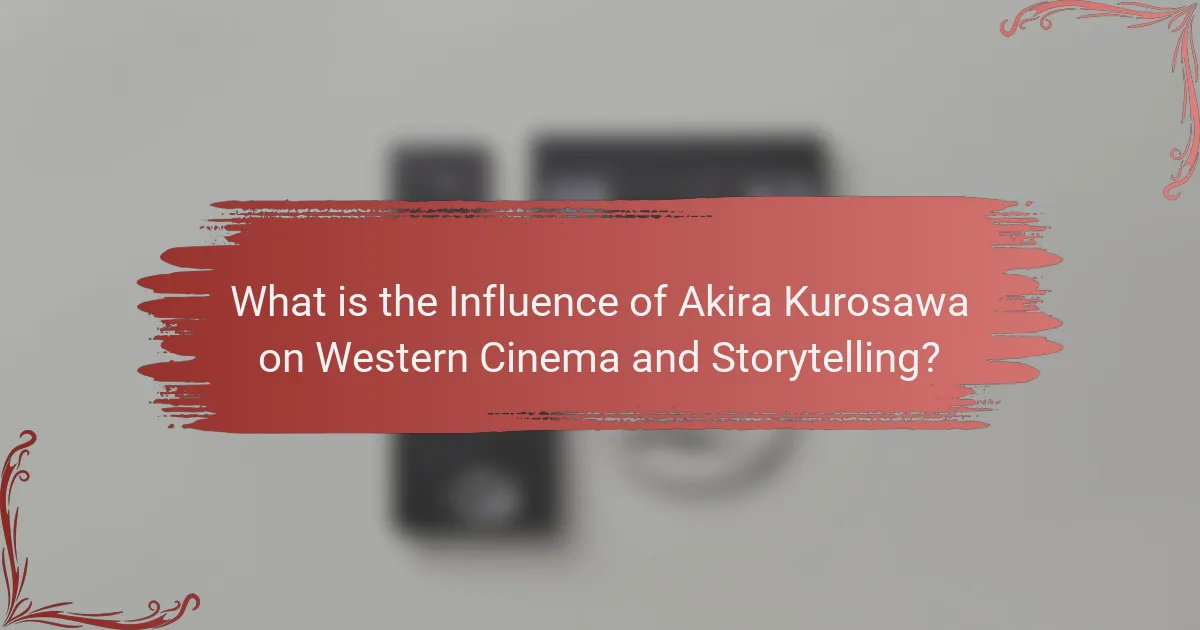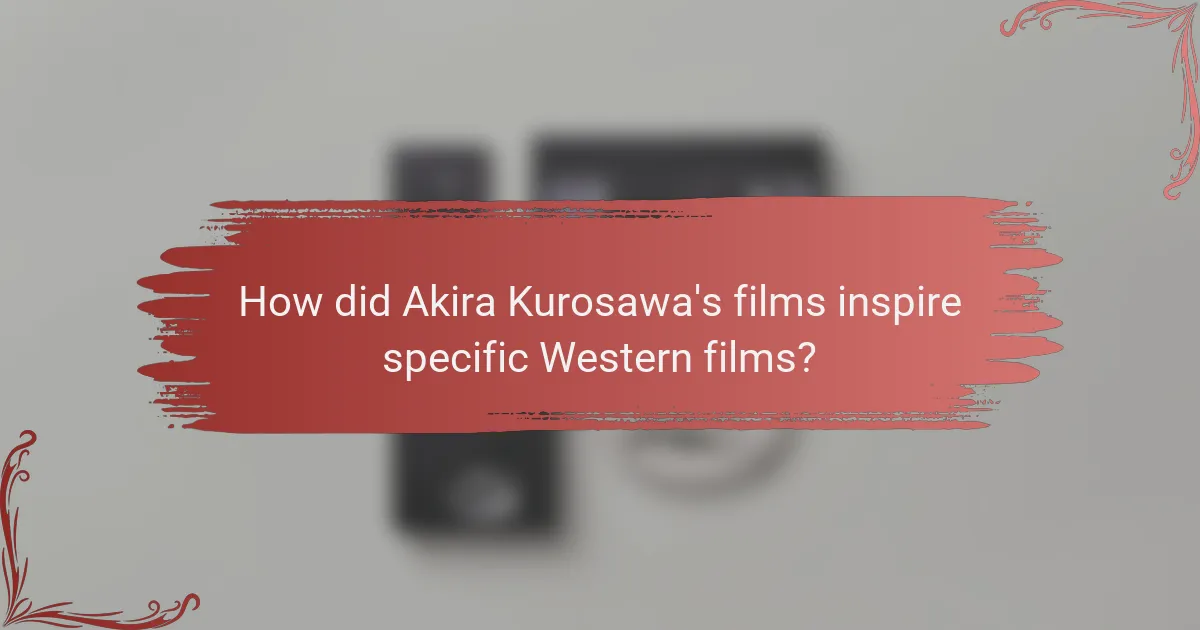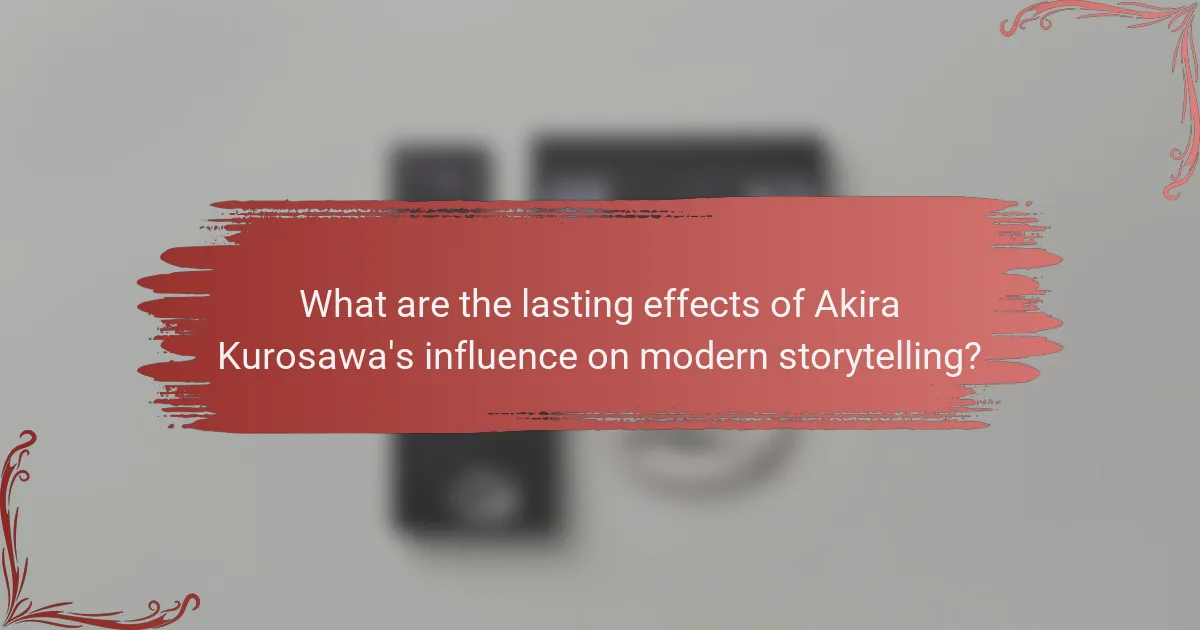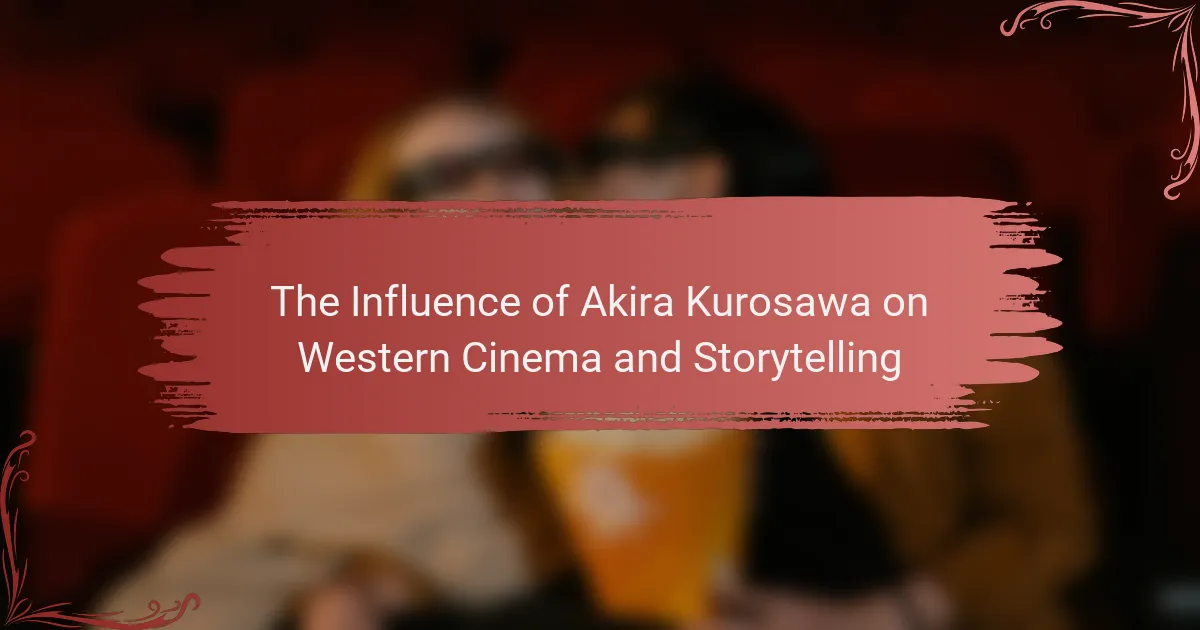Akira Kurosawa is a pivotal figure in cinema, renowned for his significant influence on Western storytelling and filmmaking. His film “Seven Samurai” set a precedent for ensemble casts and character-driven narratives, impacting numerous Western films, including “The Magnificent Seven” and “Star Wars.” Kurosawa’s innovative techniques, such as dynamic camera movements and nonlinear narratives, have become essential in modern filmmaking. His exploration of themes like honor, sacrifice, and moral ambiguity resonates deeply with audiences, bridging cultural divides and shaping the narrative landscape of both Eastern and Western cinema. His legacy continues to inspire filmmakers worldwide, fostering a blend of cinematic traditions.

What is the Influence of Akira Kurosawa on Western Cinema and Storytelling?
Akira Kurosawa significantly influenced Western cinema and storytelling through his innovative techniques and narrative structures. His film “Seven Samurai” inspired numerous Western films, particularly in the action and adventure genres. The concept of ensemble casts and character-driven narratives became prevalent in Hollywood due to his storytelling approach.
Kurosawa’s use of visual composition and dynamic camera movements set new standards for cinematography. His collaboration with composer Toru Takemitsu introduced unique soundscapes that enriched the emotional depth of films. Directors like George Lucas and Francis Ford Coppola cited Kurosawa as a major influence on their work.
The themes of honor, sacrifice, and moral ambiguity in Kurosawa’s films resonated with Western audiences, shaping the storytelling landscape. His adaptation of Shakespearean plays demonstrated the universal nature of his narratives, bridging cultural gaps. Overall, Kurosawa’s legacy continues to impact filmmakers worldwide, fostering a blend of Eastern and Western cinematic traditions.
How did Akira Kurosawa’s filmmaking style impact Western directors?
Akira Kurosawa’s filmmaking style significantly influenced Western directors through his narrative techniques and visual storytelling. His use of non-linear storytelling inspired directors like George Lucas and Francis Ford Coppola. Kurosawa’s emphasis on character development and moral complexity can be seen in films by Martin Scorsese and Quentin Tarantino. The visual composition and framing techniques he employed have influenced cinematography in Hollywood. His films, such as “Seven Samurai,” introduced Western audiences to the concept of ensemble casts. This led to a shift in how stories were told in Western cinema. The incorporation of Eastern philosophies and themes in his work has enriched the narrative depth of many Western films. Overall, Kurosawa’s impact is evident in the works of numerous influential filmmakers in the West.
What specific techniques did Kurosawa introduce to Western cinema?
Akira Kurosawa introduced several specific techniques to Western cinema. He popularized the use of deep focus, allowing multiple planes of action to be in focus simultaneously. This technique creates a more immersive viewing experience. Kurosawa also employed innovative editing techniques, such as the use of cross-cutting to build tension and enhance storytelling. His incorporation of weather elements, like rain and wind, added emotional depth to scenes. Additionally, Kurosawa’s character-driven narratives influenced Western storytelling, emphasizing moral ambiguity and complex character arcs. His visual storytelling, including dynamic camera angles and movement, set new standards for cinematic expression. These techniques have been widely adopted and adapted by numerous Western filmmakers, demonstrating Kurosawa’s lasting impact on the industry.
How did Kurosawa’s visual storytelling influence narrative structures in the West?
Kurosawa’s visual storytelling significantly influenced narrative structures in the West by introducing innovative techniques. His use of dynamic camera angles and framing created a new way to convey emotion and tension. Films like “Seven Samurai” showcased ensemble casts and multiple perspectives, which became a hallmark in Western storytelling. The incorporation of non-linear narratives in his works inspired filmmakers such as George Lucas and Francis Ford Coppola. Kurosawa’s emphasis on character-driven plots also shaped the development of complex narratives in Western cinema. His storytelling methods encouraged a deeper exploration of moral ambiguity and human psychology. The impact is evident in films like “The Magnificent Seven,” a direct adaptation of “Seven Samurai.” Overall, Kurosawa’s unique visual style and narrative innovations left a lasting legacy on Western filmmaking.
Why is Akira Kurosawa considered a pivotal figure in cinema history?
Akira Kurosawa is considered a pivotal figure in cinema history due to his innovative storytelling techniques and visual style. He introduced complex narratives and deep character development, influencing filmmakers worldwide. His films, such as “Seven Samurai,” showcased a blend of action and philosophical themes. Kurosawa’s use of weather and natural elements added emotional depth to his stories. He also popularized the use of the long take and dynamic camera movements. His work inspired numerous Western directors, including George Lucas and Francis Ford Coppola. Kurosawa’s films received critical acclaim and numerous awards, including the Academy Award for Lifetime Achievement. His legacy continues to shape modern filmmaking today.
What themes in Kurosawa’s films resonate with Western audiences?
Kurosawa’s films resonate with Western audiences through themes of honor, morality, and the human condition. His exploration of the struggle between individual desires and societal expectations reflects universal conflicts. Films like “Seven Samurai” highlight themes of sacrifice and loyalty, which are relatable across cultures. Additionally, the portrayal of flawed characters facing moral dilemmas engages viewers emotionally. The influence of these themes can be seen in Western films that adopt similar narratives. Kurosawa’s ability to blend action with philosophical depth draws in diverse audiences. His storytelling techniques have inspired many Western filmmakers, further solidifying his impact.
How did Kurosawa’s cultural background shape his storytelling approach?
Kurosawa’s cultural background significantly shaped his storytelling approach by integrating traditional Japanese themes and aesthetics. His upbringing in a society steeped in samurai culture influenced his depiction of honor, duty, and moral dilemmas. Kurosawa often drew from Japanese literature, particularly Noh and Kabuki theater, which informed his narrative structure and character development. His films reflect a blend of Eastern and Western influences, showcasing universal human experiences. For instance, “Rashomon” explores subjective truth, a concept rooted in Japanese philosophy. This melding of cultures allowed Kurosawa’s work to resonate globally, impacting Western filmmakers. His unique storytelling has inspired directors like George Lucas and Francis Ford Coppola.

How did Akira Kurosawa’s films inspire specific Western films?
Akira Kurosawa’s films inspired specific Western films through their storytelling techniques and visual style. His film “Seven Samurai” directly influenced “The Magnificent Seven.” Both films share themes of heroism and the protection of a community. Kurosawa’s use of ensemble casts set a precedent for character development in Westerns. His innovative framing and composition influenced directors like Sergio Leone in films such as “A Fistful of Dollars.” Additionally, Kurosawa’s narrative structure, including the use of flashbacks, impacted films like “Star Wars.” George Lucas acknowledged Kurosawa’s influence on his storytelling approach. The blending of Eastern and Western cinematic elements can be seen in many films inspired by Kurosawa’s work. His legacy continues to shape the landscape of Western cinema today.
Which Western films are directly influenced by Kurosawa’s work?
Several Western films are directly influenced by Akira Kurosawa’s work. Notable examples include “The Magnificent Seven,” which is a remake of Kurosawa’s “Seven Samurai.” “A Fistful of Dollars” is another film inspired by Kurosawa’s “Yojimbo.” Additionally, “The Seven Samurai” has been referenced in various Westerns, showcasing its impact on the genre. Kurosawa’s storytelling techniques and themes have shaped the narrative structure of these films. His ability to blend action with moral dilemmas resonates throughout Western cinema.
What elements from Kurosawa’s films can be seen in these Western adaptations?
Kurosawa’s films exhibit several elements that appear in Western adaptations. Themes of honor and moral ambiguity are prevalent in both Kurosawa’s works and their Western counterparts. Character archetypes, such as the anti-hero, are often mirrored in these adaptations. Visual storytelling techniques, including dynamic framing and composition, influence cinematography in Western films. The use of ensemble casts to explore complex narratives is another shared element. Additionally, the incorporation of Japanese cultural motifs can be seen in the thematic layers of Western stories. The narrative structure, often involving a journey or quest, is a common thread linking Kurosawa’s films to Western adaptations. These elements demonstrate the lasting impact of Kurosawa’s storytelling on global cinema.
How did Kurosawa’s narratives shape the plots of these Western films?
Kurosawa’s narratives significantly influenced the plots of Western films by introducing complex characters and moral ambiguity. His films often featured themes of honor, betrayal, and the human condition. These elements resonated with Western filmmakers seeking depth in storytelling. For instance, “Seven Samurai” inspired “The Magnificent Seven,” translating the ensemble of warriors into a Western context. Kurosawa’s innovative use of visual storytelling also impacted Western cinematography. His framing and composition techniques became benchmarks for directors in Hollywood. The emotional weight and philosophical undertones in his narratives encouraged Western filmmakers to explore similar themes. This cross-cultural exchange enriched the storytelling landscape in both cinema traditions.
What role did collaboration with Western filmmakers play in Kurosawa’s influence?
Collaboration with Western filmmakers significantly enhanced Akira Kurosawa’s influence. It introduced his storytelling techniques to a broader audience. His films like “The Seven Samurai” inspired Western directors such as John Sturges and George Lucas. Kurosawa’s partnership with Hollywood figures, including producer Roger Corman, facilitated cross-cultural exchanges. These collaborations led to adaptations of his works, further embedding his style in global cinema. The blending of Eastern and Western cinematic elements enriched both his films and those of his collaborators. Ultimately, these interactions helped shape modern filmmaking practices in the West.
How did partnerships with Western producers enhance the global reach of Kurosawa’s films?
Partnerships with Western producers significantly enhanced the global reach of Kurosawa’s films. These collaborations allowed for increased distribution and marketing resources. For instance, the partnership with Hollywood studios helped to introduce his work to wider audiences. Kurosawa’s films, such as “The Seven Samurai,” gained international acclaim through these connections. Additionally, Western producers facilitated subtitling and dubbing, making films accessible to non-Japanese viewers. The involvement of Western talent also attracted attention and credibility. This led to greater recognition at international film festivals. Overall, such partnerships expanded the cultural impact of his films beyond Japan.
What insights did Western filmmakers gain from working with Kurosawa?
Western filmmakers gained insights into narrative structure and character development from working with Akira Kurosawa. His films often featured complex characters and moral ambiguity. This encouraged Western directors to explore deeper emotional narratives. Kurosawa’s use of visual storytelling influenced cinematography techniques in Hollywood. His innovative framing and composition inspired new approaches to visual aesthetics. Additionally, Kurosawa’s blending of genres demonstrated the power of cross-cultural storytelling. This encouraged filmmakers to experiment beyond traditional genre boundaries. His influence is evident in films like “Star Wars” and “The Magnificent Seven,” which were directly inspired by his work.

What are the lasting effects of Akira Kurosawa’s influence on modern storytelling?
Akira Kurosawa’s influence on modern storytelling is profound and enduring. His narrative techniques have shaped cinematic storytelling worldwide. He popularized the use of nonlinear narratives, which are now common in contemporary films. Kurosawa’s character development emphasized moral complexity, influencing how characters are portrayed today. His films often incorporate themes of honor, conflict, and redemption, which resonate in modern narratives. The visual storytelling techniques he employed, such as dynamic camera angles and composition, have become staples in filmmaking. His adaptation of literary works into film has inspired countless filmmakers to explore similar methods. Notably, films like “Star Wars” and “The Magnificent Seven” directly draw from Kurosawa’s storytelling style and themes. His legacy continues to inspire filmmakers and storytellers across genres and cultures.
How has Kurosawa’s legacy shaped contemporary cinema?
Kurosawa’s legacy has profoundly shaped contemporary cinema through his innovative storytelling techniques. His use of non-linear narratives influenced filmmakers worldwide. Films like “Rashomon” introduced multiple perspectives, changing how stories are told. Kurosawa’s visual style, including dynamic camera movements, set a new standard for cinematography. His emphasis on character development over plot has resonated with modern filmmakers. Directors such as George Lucas and Martin Scorsese cite Kurosawa as a major influence on their work. The thematic depth in Kurosawa’s films, exploring morality and human nature, continues to inspire contemporary narratives. His adaptation of Western genres into Japanese contexts has also paved the way for cross-cultural storytelling in film.
What storytelling techniques inspired by Kurosawa are prevalent in today’s films?
Kurosawa’s storytelling techniques that are prevalent in today’s films include non-linear narratives and complex character development. Non-linear storytelling allows filmmakers to present events out of chronological order, enhancing suspense and emotional depth. This technique is evident in films like “Pulp Fiction” by Quentin Tarantino, which draws inspiration from Kurosawa’s “Rashomon.”
Additionally, Kurosawa’s focus on character motivations and moral ambiguity influences modern storytelling. His characters often face ethical dilemmas, which can be seen in contemporary films such as “The Last Jedi” where characters grapple with their decisions.
Moreover, the use of visual storytelling and composition, such as framing and movement, is another technique derived from Kurosawa. Directors like Christopher Nolan incorporate these visual elements to convey themes and emotions, akin to Kurosawa’s cinematic style.
Overall, these storytelling techniques reflect Kurosawa’s lasting impact on filmmakers and narrative structures in modern cinema.
How do modern filmmakers pay homage to Kurosawa’s work?
Modern filmmakers pay homage to Kurosawa’s work through stylistic and narrative techniques. They often adopt his use of visual composition and framing. Many incorporate themes of honor, morality, and the human condition, prevalent in Kurosawa’s films. Filmmakers like George Lucas and Francis Ford Coppola have cited Kurosawa as an influence. Lucas’s “Star Wars” draws on Kurosawa’s storytelling methods, particularly the hero’s journey. Quentin Tarantino’s “Kill Bill” pays tribute to Kurosawa’s “Seven Samurai” through its ensemble cast and action sequences. Additionally, films like “The Magnificent Seven” are direct remakes of Kurosawa’s “Seven Samurai.” These examples illustrate the lasting impact of Kurosawa’s cinematic language on contemporary filmmaking.
What can aspiring filmmakers learn from Akira Kurosawa’s storytelling methods?
Aspiring filmmakers can learn the importance of character depth from Akira Kurosawa’s storytelling methods. Kurosawa often developed multifaceted characters with clear motivations. This approach enhances audience engagement and emotional investment. Additionally, he utilized the concept of the “hero’s journey,” which resonates with viewers universally. His films frequently explored themes of honor, morality, and the human condition. This thematic richness allows for layered narratives that provoke thought. Kurosawa also employed innovative cinematography techniques to enhance storytelling. For instance, his use of weather and landscape reflected character emotions and plot developments. These techniques have influenced countless filmmakers and are evident in modern cinema.
What practical tips can be applied from Kurosawa’s techniques in filmmaking?
Kurosawa’s filmmaking techniques offer several practical tips. First, he emphasized the importance of strong character development. This approach creates relatable and compelling narratives. Second, he utilized weather as a storytelling device. This technique enhances emotional resonance in scenes. Third, Kurosawa often employed dynamic camera movements. This method adds visual interest and engagement. Fourth, he practiced meticulous storyboarding. This ensures clarity in visual storytelling and pacing. Finally, Kurosawa’s use of silence and pauses creates tension. This technique allows audiences to absorb key moments. These tips reflect Kurosawa’s mastery in crafting impactful cinema.
How can understanding Kurosawa’s influence enhance a filmmaker’s craft?
Understanding Kurosawa’s influence can significantly enhance a filmmaker’s craft by providing insights into narrative structure and visual storytelling. Kurosawa pioneered techniques such as the use of weather to reflect character emotions and the integration of multiple perspectives in storytelling. His films often explore universal themes, which can inspire filmmakers to create more relatable and impactful narratives.
Additionally, Kurosawa’s collaboration with actors emphasized character development, encouraging filmmakers to prioritize performance in their works. His unique editing style, particularly the use of long takes and dynamic camera movements, offers valuable lessons in pacing and visual rhythm.
Kurosawa’s influence on genres, particularly the samurai film and its adaptation in Westerns, showcases the importance of cultural exchange in filmmaking. By studying his work, filmmakers can learn to blend diverse influences to create innovative narratives. Overall, understanding Kurosawa’s approach can lead to a richer, more nuanced filmmaking practice.
Akira Kurosawa is a pivotal figure in cinema known for his profound influence on Western filmmaking and storytelling. His innovative techniques, such as non-linear narratives, character-driven plots, and dynamic visual composition, have shaped the narrative structures of numerous Western films. Key themes in his work, including honor and moral ambiguity, resonate with global audiences and have inspired filmmakers like George Lucas and Quentin Tarantino. This article explores Kurosawa’s impact on modern cinema, highlighting specific techniques and thematic elements that continue to enrich contemporary storytelling. The lasting effects of his legacy are evident in the works of many influential directors and the evolution of narrative forms in film.
